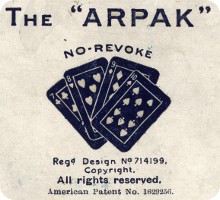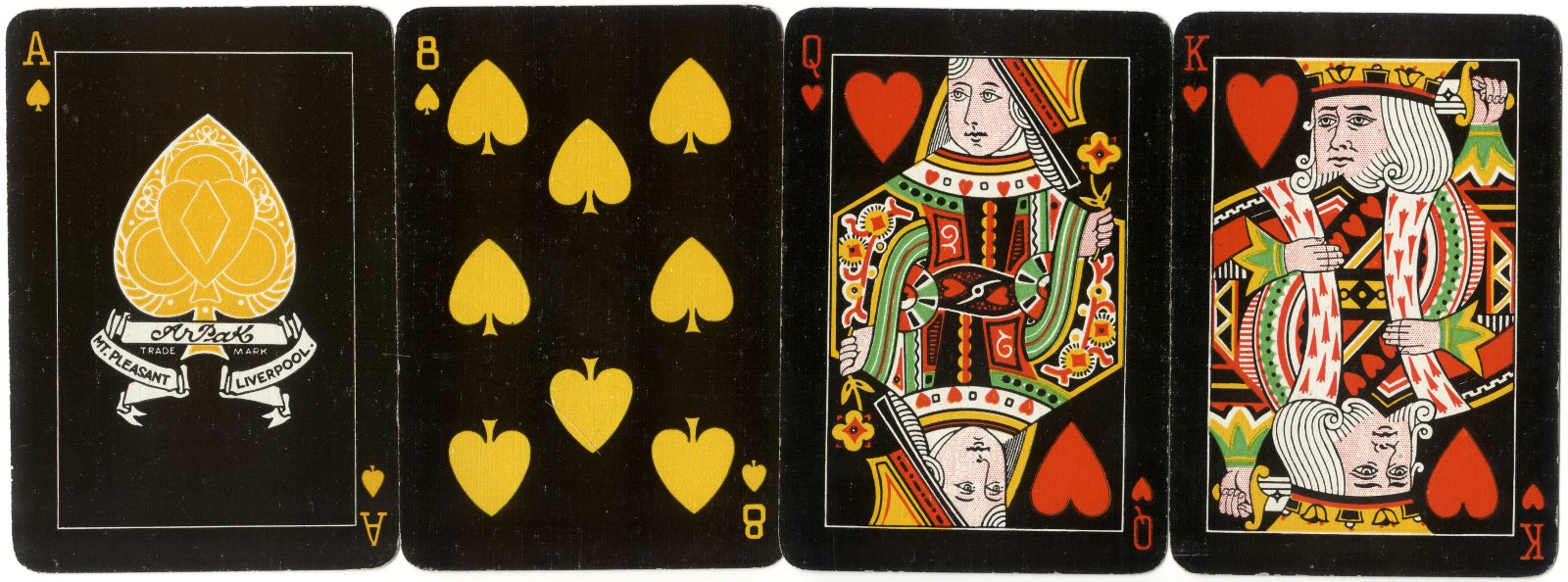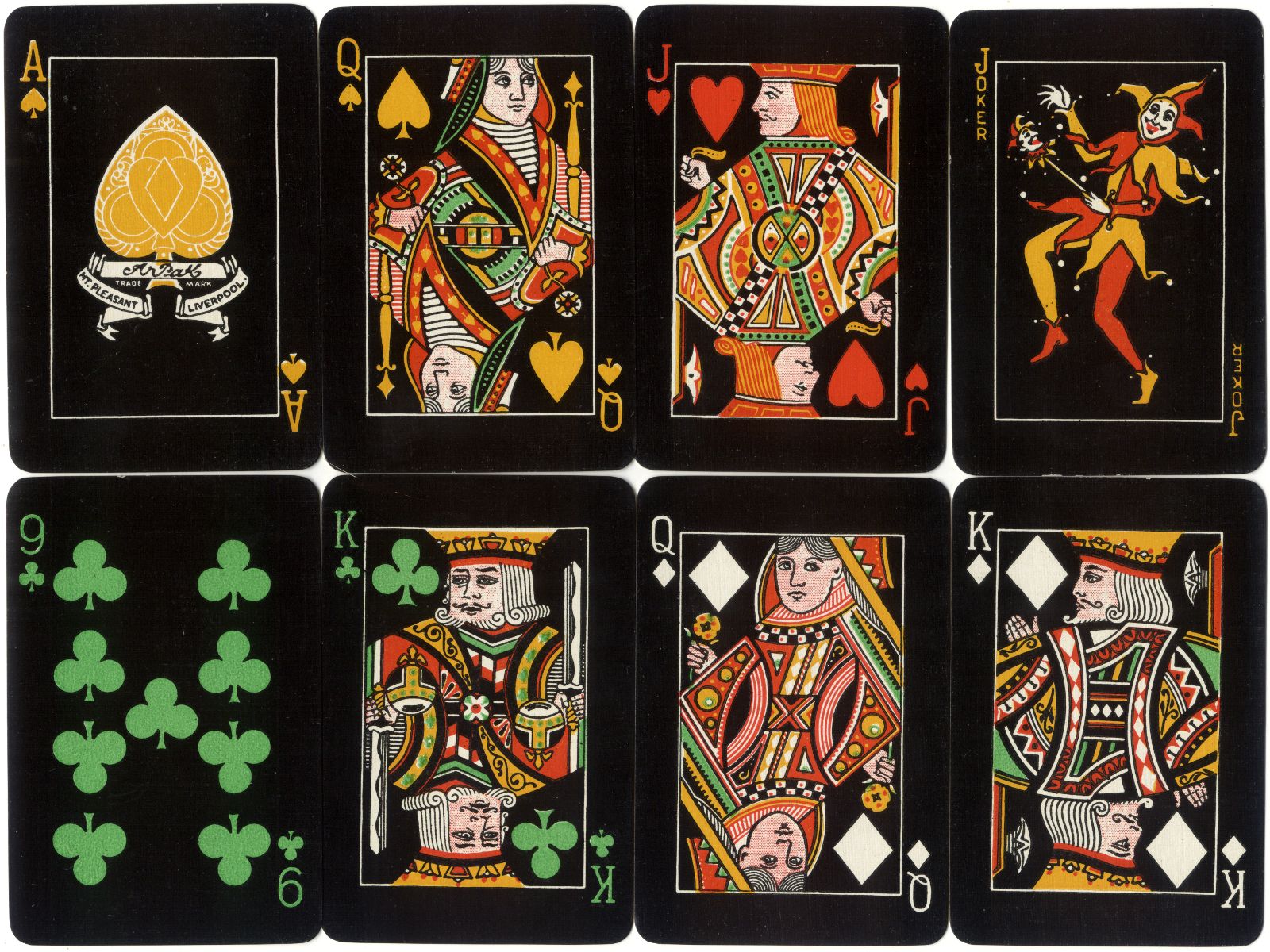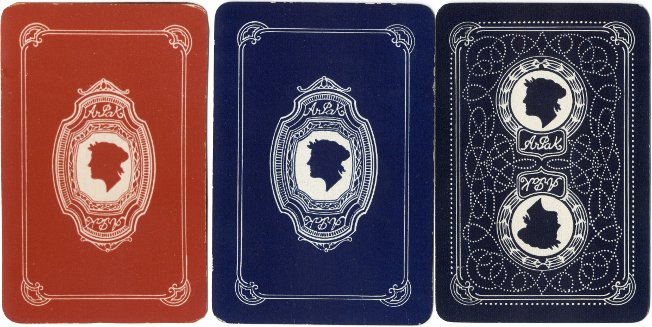Arpak
The Arpak No-Revoke playing cards, 24 Mount Pleasant, Liverpool, c.1927-35.

Arpak No-Revoke playing cards
The “Arpak” Playing Card Co, 24 Mount Pleasant, Liverpool, England, c.1927-35
All cards are on a black background which makes them look rather striking. The suit symbols and pips are coloured, intended to help reduce eye strain for people who find it difficult to distinguish the suit signs: spades-yellow, diamonds-white, clubs-green and hearts-red. Packs have 52 cards + 1 joker. Several different formal back designs are known, in red or blue and white, and some decks have gold edges. There are two different sizes of indices and widths of outer borders. Arpak ‘No-revoke’ decks are also known with advertisements on the reverse.
Small Indices

Large Indices


Above & Left: Arpak No-Revoke playing cards, c.1930, showing both sizes of indices, the Joker and some common back designs.
There was no uniformity or standardisation regarding the colour scheme in different No-revoke packs. De la Rue introduced an ‘Optic’ pack in 1900 with spades-blue, diamonds-yellow, clubs-black and hearts-red. De la Rue & Co issued another pack in 1915 with spades-black, diamonds-orange, clubs-blue and hearts-carmine. Universal Playing Card Co Ltd introduced their No-revoke pack in 1930 with spades-black, diamonds-red, clubs in black hatching and hearts in red hatching. Waddington's introduced their No-revoke pack in 1930 with spades-black, diamonds in red diagonal stripes, clubs in black & white and hearts-red.
Different coloured suit symbols had been patented in USA on Nov 23, 1926, by Antoine Lefebure of San Francisco, with the assertion that “even experienced players confuse clubs and spades; hearts and diamonds” see more →
The Arpak Playing Card Company was also involved in a patent for improvements in fountain pens (1928)►
See also: John Newman's Colour Cards►

By Simon Wintle
Member since February 01, 1996
I am the founder of The World of Playing Cards (est. 1996), a website dedicated to the history, artistry and cultural significance of playing cards and tarot. Over the years I have researched various areas of the subject, acquired and traded collections and contributed as a committee member of the IPCS and graphics editor of The Playing-Card journal. Having lived in Chile, England, Wales, and now Spain, these experiences have shaped my work and passion for playing cards. Amongst my achievements is producing a limited-edition replica of a 17th-century English pack using woodblocks and stencils—a labour of love. Today, the World of Playing Cards is a global collaborative project, with my son Adam serving as the technical driving force behind its development. His innovative efforts have helped shape the site into the thriving hub it is today. You are warmly invited to become a contributor and share your enthusiasm.
Related Articles

Songs with Flute accompaniment
Eighteenth century English engraved cards with music for voice and flute.

Love Tests
Vintage novelty “Love Test” cards of a slightly saucy nature but all in good fun!

Ben 10 playing cards
Characters from the American animated television science fantasy series Ben 10.

Doctor Who Trump Card Game
Game for two players in which Doctor Who and the Legendary Legion join battle with the Alien Hordes....

Disney’s Aladdin playing cards
Characters from the 1992 Disney film Aladdin.

2011 Worshipful Company Pack
Celebrating the bicentenary of the birth of Charles Dickens, with characters adapted from drawings b...

Jockey Club de Buenos Aires
Spanish-suited pack by Chas Goodall & Son Ltd for the Jockey Club, Buenos Aires.

New interest in old games
Games once fashionable are now eclipsed by quicker gratifications.

Polygo™
Cards of irregular, four-sided shape for playing word and colour games as well as more traditional o...

Treasures from the Bodleian Library
Rare books, manuscripts, music scores, portraits, maps, gospels, chronicles and other valuable artef...

Seminole Wars deck
Seminole Wars deck by J. Y. Humphreys, Philadelphia, c.1819.

Victorian grocer’s scale plate
Large flat plate decorated with highly coloured English cards and royal arms.

Queen of Arts
A wide variety of women artists celebrated on cards with illustrations by Laura Callaghan.

The Glasgow Pack
Issued to celebrate Glasgow’s reign as European City of Culture in 1990, with city views and works o...

Cathedrals, Abbeys & Minsters playing cards
54 pictures of different famous cathedrals, abbeys and minsters in England and Wales.

Christmas Carols
Christmas Carols playing cards illustrated by Stuart Dilks
Most Popular
Our top articles from the past 28 days

